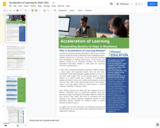
Acceleration of Learning- Responding Quickly to Gaps in Learning
- Subject:
- Education
- Material Type:
- Teaching/Learning Strategy
- Date Added:
- 10/18/2022

Acceleration of Learning- Responding Quickly to Gaps in Learning

This segment from Swift: Eyes through Time traces the history military officers and engineers discovering a strange phenomenon in the sky that astronomers now know are gamma-ray bursts.
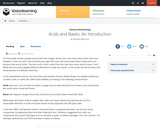
This module provides an intrioduction to acid and base chemistry. The Arrhenius and Bronsted-Lowry concepts of acids and bases are discussed as well as the pH scale and neutralization reactions.

In this video segment, the ZOOM cast demonstrates how to use cabbage juice to find out if a solution is an acid or a base.
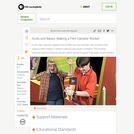
In this video segment adapted from ZOOM, two cast members demonstrate what happens when vinegar is added to baking soda inside a container. The resulting chemical reaction produces enough carbon dioxide to launch their paper rocket skyward.
Recommended for: Grades K-5
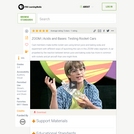
A car propelled by the reaction between lemon juice and baking soda has more in common with rockets and jet aircraft than one might think. In this video segment adapted from ZOOM, two cast members demonstrate the power of rocket-propelled vehicles and how to exploit the force produced by the carbon dioxide gas. Grades 3-8.
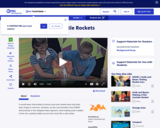
It would seem that bottles of lemon juice and rockets have only their basic shape in common. However, as two cast members from ZOOM demonstrate in this adapted video segment, when baking soda is added to the mix, a plastic bottle can act very much like a real rocket. Grades 3-8.

How can you use the Engineering Design Process to access a geographically inaccessible location to deliver supplies?
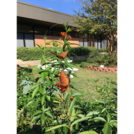
Students will use knowledge of adaptations to compare the structures and functions of plants. These likenesses are passed down between parent plants and their offspring
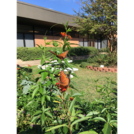
STUDENT ACTIVITY – 4th -- TXThis is a distance-learning lesson students can complete at home.Students will use knowledge of adaptations to compare the structures and functions of plants. These likenesses are passed down between parent plants and their offspring.This activity was created by Out Teach (out-teach.org), a nonprofit providing outdoor experiential learning to transform Science education for students in under-served communities. .

This lesson will tie into the Nebraska science standards below. Students will learn how to search Worldbook KIDS online to study different animals and plants, as a class and independently. With a teacher’s help, students will then learn about animal and plant adaptations that help them survive in their habitats in order to come up with a solution to a human problem. The standards in bold print are the ones that will be the classroom teacher’s focus, but the librarian’s goal will be to introduce students to Worldbook KIDS as a reference source.It can easily be adapted to be a whole unit. Please let me know if you would like to help/edit this lesson to enhance it!
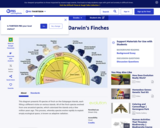
Finches on the Galapagos Islands have evolved to exploit almost every possible niche. This diagram shows the range of food sources available on the island and the different beak shapes adapted to exploit each of them.
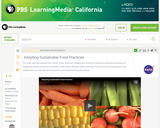
Hear about how respect for Earth can help us attain a more sustainable lifestyle in the face of climate change in this video segment adapted from United Tribes Technical College.

This course offers analysis and practice of various forms of scientific and technical writing, from memos to journal articles, in addition to strategies for conveying technical information to specialist and non-specialist audiences. Comparable to 21W.780 Communicating in Technical Organizations, but methods in this course are designed to deal with special problems of advanced ELS or bilingual students. The goal of the workshop is to develop effective writing skills for academic and professional contexts. Models, materials, topics and assignments vary from term to term.

Our brains control every movement we make. Most of us take for granted our ability to pick up a cup or change the television station. However, for people who have lost a limb or become paralyzed, the inability to do these things means a loss of freedom and independence. This video segment from Greater Boston describes how neuroscientists and bioengineers have teamed up to create a system that allows people who have lost motor functions to control electronic devices through their thoughts alone. Grades 6-12
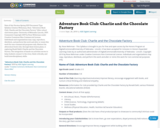
Date of this Version
Spring 2019
Document Type
Syllabus
Citation
Wehrman, Rose. "Adventure Book Club: Charlie and the Chocolate Factory." After school club lesson plans. University of Nebraska-Lincoln, 2019.
Comments
Copyright 2019 by Rose Wehrman under Creative Commons Non-Commercial License. Individuals and organizations may copy, reproduce, distribute, and perform this work and alter or remix this work for non-commercial purposes only.
Abstract
An afterschool book club, through these lesson plans, is exploring Roald Dahl's Charlie and the Chocolate Factory. The integration of hands-on activities serves to help students connect to the story, think critically, and build interdisciplinary skills.

In this video from Nature, geological detectives use ancient diamonds to learn more about Earth's inner layers.
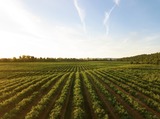
Agricultural Connections is a middle school curricular program framework created by EarthGen. For this unit, we offer professional development training and assistance with implementation. Please let us know if you are interested in implementing this program at your school or district! Please contact info@earthgenwa.org for more information.
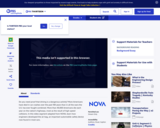
Do you need proof that driving is a dangerous activity? More Americans have died in car crashes over the past 100 years than in all the wars the U.S. has ever fought combined. More than 40,000 Americans die each year on the nation's highways, most as the result of high-speed collisions. In this video segment adapted from NOVA, learn how engineers developed the air bag, an important automobile-safety device now found in most cars.
Recommended for: Grades 3-12
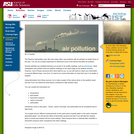
The Phoenix metropolitan area, like many large cities, has problems with air pollution at certain times of the year. You can do a simple experiment to determine some of the factors that affect air pollution.